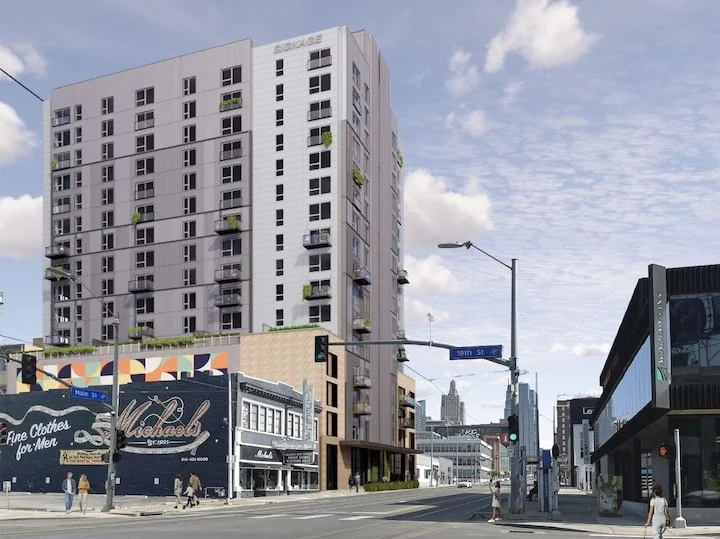Feature image/rendering credit: Generator Studio
KC women in CRE leading with grit and grace
Are sale-leasebacks a good fit for your business?
In a sale-leaseback, a company sells their property to an investor who leases the building back to the company under prearranged terms. The lease is usually for a term of 5 to 20 years with renewal options. The sale provides the now-tenant with a swift infusion of capital to pay down existing debt or reinvest into its business, while the buyer/investor grows its real estate portfolio with a paying tenant in tow.
Typically, the company enters into a triple-net lease whereby it is responsible for costs of maintenance and all upkeep, real estate taxes and insurance. The rent paid by the company is based upon a combination of market rents, credit of the company, the buyer’s financing cost and required return on equity. A sale-lease back is an alternative for all property types including office buildings, warehouses, manufacturing plants and retail stores.
Advantages of a sale-leaseback transaction for a company include:
1. Unlocking capital from a non-performing asset to invest in core business at a greater rate of return or to reduce debt;
2. Improving their balance sheet by removing depreciation and mortgage debt;
3. Generating more capital (100% of market value) than typical mortgage financing;
4. Continuing to have operational control of the property;
5. Determining to a considerable extent their own sale price, lease rate and renewal options.
A sale-leaseback is an attractive alternative in both good and bad economic times. The ongoing pandemic is severely affecting many businesses’ revenue, working capital is limited, lending guidelines are more stringent than in prior years and M&A activity likely will increase.
In addition, interest rates are low. These conditions represent a strong environment for sale-leasebacks. In a good economy, a sale-leaseback generates more capital than traditional mortgage financing. In a bad economy, a sale-leaseback of real estate holdings provides capital when companies are unable to obtain bank financing or raise capital through public offerings.
A misconception that many people have about a sale-leaseback is that the company has no control over the property. However, remember that the lease is long-term and typically renewal options can be negotiated to provide further control for the company.
In addition, in some respects a company has more control by leasing rather than owning because it has more options upon the lease expiration. These include exercising a pre-negotiated renewal option, negotiating a renewal based upon current market conditions, or relocating to a new facility that better accommodates the operation at that time. As an example, for a warehousing operation this could mean relocating to a larger facility, smaller facility or a different geographic area that better accommodates current distribution requirements.
Sale-leasebacks are not just an option for public companies. Private companies that are looking for ways to generate capital to invest in equipment or reduce debt should consider the advantages of the sale-leaseback transaction. In addition, private equity firms that have purchased a company or taken it private often will consider a sale-leaseback to generate funds for the purchase.
Another twist to a typical sale-leaseback is a partial sale-leaseback. Assuming that the property can be economically modified for multi-tenant use, this option allows a company to downsize in their existing facility while still generating capital to be redeployed as needed.
If considering a sale-leaseback, the first step is to engage the services of a commercial real estate professional that specializes in this type of investment transaction. This will allow you to evaluate your various options and potential market value of the real estate. Your accountant and legal counsel should also be involved in evaluating the advantages and disadvantages of this type of transaction based upon your company’s particular situation.
The next step is implementation of a professional marketing plan to position the offering and present it to the likely buyers of the particular type of real estate. Depending upon the type of property and credit of the seller/tenant, potential buyers can include real estate investment trusts (REITs) which specialize in triple net leases, national private equity funds that focus on sale-leasebacks and individual investors.
Consider the advantages of a sale-leaseback transaction for your company.
Michael L. VanBuskirk, SIOR, CCIM, CRE is executive managing director-principal at Newmark Zimmer with over 26 years of experience in investment sales/acquisitions, corporate services, development and real estate consulting. VanBuskirk can be reached at 816-512-1010 or mvanbuskirk@ngzimmer.com.
Christopher S. Robertson, CCIM is senior managing director of investment Ssles and capital markets at Newmark Zimmer. He has over 7 years of experience in investment sales/acquisitions, appraisal, financial analysis and real estate consulting. Chris can be reached at 816-512-1014 or crobertson@ngzimmer.com.
Second + Delaware among world’s largest passive housing projects
CCIM economist navigates road to recovery
K.C. Conway, chief economist of the CCIM Institute and director of research for Alabama Center for Real Estate, delivered an economic update webinar to commercial real estate professionals last week.
As a whole, Conway believes the economy, which spiraled downward with the COVID-19 lockdowns, is far from recovery, a perspective reinforced by recent comments from Jerome Powell, chair of the Federal Reserve.
“If we were recovering and creating 2.5 million jobs a month, do you think the Fed would make the statement that it was not even thinking about making interest rate hikes until 2022? Not even 2021? This tells you how fragile the economy is; how much intervention the Fed is going to have to do,” Conway said.
Conway predicts that there will be a massive oversupply of oil as supply cut production agreements expire at the end of June.
“I think energy is going to remain very, very volatile. That’s good for the consumer and for transportation, but it’s not a good indicator that things are really recovering from the economy. I don’t think energy is saying we’re there yet either,” Conway said.
The housing market also does not reflect a recovery. With eight percent of mortgages subject to forbearance agreements which won’t expire for six to 12 months, Conway said we’re not going to fully understand the impact of housing until next spring.
“When you also look at what’s rising in terms of mortgage delinquencies, we’re essentially at 15% of all homeowners delinquent in their mortgages or in forbearance, and that’s record numbers even compared to 2009,” noted Conway.
According to Conway, there are four metrics which are most predictive in determining when we’ve arrived at recovery. The first is the Transportation Security Administration (TSA) daily passenger count, which is currently in the 200,000 to 300,000 range.
“If we don’t see this climb back toward 1.5 million this fall, we are in serious trouble," Conway said.
The second metric upon which he relies is the number of loans transferred to special servicers. He noted that these loan transfers are reaching record numbers.
The third predictive metric is transaction activity. Conway said that activity currently is locked up because the 500 largest pension and institutional funds are not investing in commercial real estate until they get past their mark to market accounting at the end of June and determine how to reallocate capital. However, Conway is optimistic.
“Capital is coming back this fall to commercial real estate,” he said.
The fourth and final predictive metric is corporate earnings. He encouraged his audience to follow the earnings of companies that drive their local economies, including those companies that are the major tenants of local retail centers and office buildings.
Conway also predicts major changes to logistics.
“What we’re going to see is the rest of the world awaken to the fact that it’s a really bad idea to put all of your manufacturing dependence in one place in the world.”
Consequently, he said some of the manufacturing currently done in China or other parts of Asia will move back to Europe and the United States, but much will go to Mexico, increasing the importance of Kansas City, local intermodal installations and Kansas City rail as trade moves more north and south, rather than from the west coast to the east coast.
Conway noted that casualties of the pandemic will include the failure of one in four businesses and the closure of 40 percent of restaurants nationally. Consequently, a lot of inventory and equipment that was ordered pre-pandemic but not shipped during the shutdown will arrive at businesses that have closed.
“That’s about 50 million SF of additional warehouse space that we’re going to have to have to store orders that have finally come in. This will provide adaptive reuse opportunities for properties like closed big box retailers and department stores in enclosed malls,” Conway said.
Conway predicts leisure and travel properties will change substantially as well, shifting hotels in the future to be smaller with exterior room entry and contactless features.
In addition, Conway sees every ratio to which the commercial real estate industry is accustomed, to change.
“Density ratios in office, density ratios in restaurants, expense ratios, occupancy cost ratios . . . parking ratios because we’re going to do more ‘click it and pick up,’ rather than ‘park and drive in,’ which will add a whole new dimension to future site selection,” Conway said.
“What I think is going to make the difference is what’s called immunity passports,” which currently are being utilized in Europe.
Immunity passports in the United States will rely upon technology that is already available, although HIPAA laws will need to be amended.
Conway predicts that within two years, we are going to have mouth swab kits to test for antibodies.








